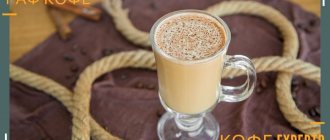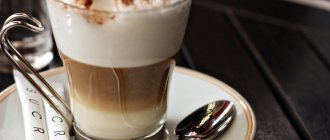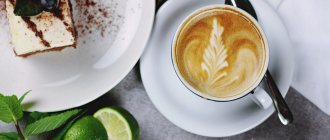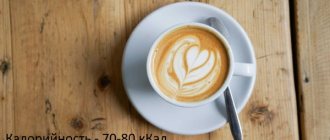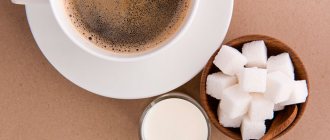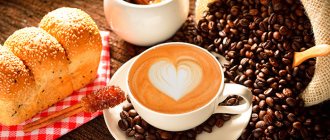Calorie content of lattes from McDonald's and Starbucks
There is an opinion that coffee from McDonald's and similar fast foods has more calories than homemade coffee.
This is only half true. Simple servings contain only ground coffee, water, milk and optional sugar or syrup. Refined sugar or sweet sticks in such places are usually given with you, it is included in the price, but whether to use a sweetener or not is everyone’s personal choice. Coffee becomes richer in calories when it is additionally decorated with whipped cream, toppings, and crushed nuts. The creamy dome contains approximately 25-80 kcal, and the nuts contain another 60-80 kcal. To reduce calories and make coffee healthier, it is advisable to give up excess carbohydrates, that is, syrups and sugar.
McDonald's and branded coffee shops indicate the composition, BJU and final calorie content of the latte coffee so that customers do not have to calculate it themselves:
- in Mak it is 140 kcal/360 ml, 210 kcal/480 ml;
- at Starbucks – 250 kcal/480 ml in the caramel version;
- at CoffeeHouse – 111 kcal/250 ml in a classic latte and 73 kcal in a low-fat one.
Instant coffee latte drinks contain a fixed amount of calories regardless of the volume of water. Usually their number is indicated on the package next to the BJU and can be 50-100 kcal.
History of the origin of coffee
The wonderful property of coffee beans to induce cheerfulness and activity was discovered back in 850 AD. e. At first, people chewed raw grains, but later they learned to roast them to get a more attractive taste. The area where the discovery was made was called Kafa (that's where the name of the drink comes from).
The roasted and ground grains used to make the drink first came from Ethiopia to Egypt, Turkey, Brazil and further around the world.
Most of the tests with this drink were carried out by the Arabs. Thanks to their efforts, coffee with milk, with various spices (cinnamon, ginger), appeared.
For a long time the drink was considered Muslim. At the end of the 16th century it appeared in Europe. Coffee shops began to open there, where one could find out the taste of this “devilish drink.”
At first, coffee was consumed to give energy, and only later they began to pay attention to its energy value: 100 g - 7 kcal, proteins - 0.2 g, fats - 0.5 g, carbohydrates - 0.2 g.
Coffee is prepared by brewing, infusing and using a coffee machine.
This is a drink when, in addition to the coffee itself, milk is poured into a cup using a special method, and thick milk foam appears on top.
The origin of the drink dates back to the 16th century. That’s when a type of coffee appeared in Italy that is still popular today.
One of the legends tells about the origin of the name of the drink. It is believed that the name is associated with the Capuchin monks, who wore dark robes with a snow-white hood. The monks loved coffee very much, but because it was expensive, they began to add milk to get more volume.
A regular cappuccino is prepared on a base that includes water and ground coffee beans (espresso), adding milk or milk foam. If you choose excellent varieties of grains, the drink will turn out tender and fragrant.
It is very convenient to prepare cappuccino in a coffee machine, but you can also do without it by using a French press.
What's in a cappuccino?
The name was given to it because of the similarity of the color palette between the drink and the clothes of the Capuchins. According to the traditional recipe, to make it you need to pour milk and milk foam into hot espresso. Aspects in the process of preparing cappuccino are that you need to watch the temperature of the milk, which should not boil, and the accuracy of adding milk ingredients to strong espresso. If milk is chosen with more fat, then the taste of the drink will be more wonderful. Spices and sweet ingredients are used as additives. It depends on personal preference. But a real drink differs from a fake one in two ways: the presence of a bitter taste of coffee and the correct ratio of milk.
Warnings for those for whom cappuccino may be harmful
- If lactose deficiency is detected, then a coffee drink with milk is dangerous. Because due to milk intolerance, a person may experience diarrhea after drinking cappuccino.
- If you are allergic to coffee or milk products, drinking all types of drinks based on coffee beans is unsafe.
- Drinking cappuccino is contraindicated for old people whose bones become more fragile over the years. Drinking a cup of coffee affects the absorption of adequate calcium, which is already not enough in the development of osteoporosis.
Calorie content of cappuccino with and without sugar
The nutritional value of coffee varies depending on its composition. For a regular drink without milk and sugar, this figure is uniquely low - 100 g of product contains only 2 kcal. The calorie content of cappuccino is higher.
Traditionally, to prepare 100 g of the drink, use:
- water – 100 g;
- milk – 100 g;
- coffee – 2 tsp;
- cinnamon – ½ tsp.
Properly prepared milk is said to have a slight sweet taste, so there is no need to use sugar. It is used as desired. Sweet crystals increase the nutritional value of the composition by approximately 1.5–2 times.
Average calorie content of cappuccino:
| Variety | Calorie content, kcal per 100 g |
| Sugarless | |
| with soy milk | 19-22 |
| from McDonald's | 42 |
| with milk 1.5% fat | 38-42 |
| with milk 2.5% fat | 44-48 |
| with milk 3.5% fat | 52-54 |
| with cream 10% fat | 92-94 |
| from a machine gun | 105 |
| with cream 20% fat | 140-148 |
| With sugar | |
| with soy milk | 45-47 |
| from McDonald's | 67 |
| with milk 1.5% fat | 75-85 |
| with milk 2.5% fat | 80-90 |
| with milk 3.5% fat | 90-95 |
| from a machine gun | 124-132 |
| with cream 10% fat | 130-135 |
| with cream 20% fat | 180-185 |
| with full fat milk and vanilla | 185-190 |
100 g of cappuccino contains on average from 105 to 120 kcal. The volume of a standard serving of coffee is approximately 155–175 ml, calorie content is about 210 kcal.
Nutritional value of additional products:
- 1 tsp. sugar - 24 kcal;
- 20 g of cream (depending on fat content) - from 20 to 60 calories;
- 2 tbsp. l. milk (2.5%) - 21 kcal;
- 1 tsp. condensed product - 35 kcal;
- 1 tsp. chocolate syrup - approximately 15 kcal.
The calorie content of the drink will increase if you use milk with high fat content, as well as cream for foam. Cognac, cinnamon, and nuts can greatly increase the nutritional value of cappuccino coffee. And you can reduce the rate if you use natural juice and low-fat foods.
Starbucks is a well-known company with a chain of coffee shops around the world. The establishments offer a special diet drink that resembles the popular cappuccino in appearance and taste. 100 g of a low-calorie product from this manufacturer contains only about 20 kcal. Skim milk is used as the milk base for this coffee, and cane sugar is used instead of traditional sugar. In some versions, agave syrup or honey is used instead of such sweetness. You can also order a product prepared according to a special recipe with a unique syrup flavor produced by the company. True, there is no caffeine in the Starbucks drink.
Menu for diet
While on a diet, you can only drink a latte that you prepare yourself (preferably using a coffee machine, but you can use whole coffee beans), without adding sugar or syrups.
Only skim or 2.5% fat milk is used. This drink, unlike natural coffee without additives, is not the basis of mono-diets or fasting days, but is included in the diet for consumption in the morning or as a snack, since it perfectly dulls the feeling of hunger and gives the body the energy necessary for work and sports.
Diet rules:
- The diet includes only low-calorie foods, such as low-starch vegetables and fruits, fermented milk products, cereals, lean meats, fish and poultry.
- It is prohibited to consume fatty foods, confectionery, sugar, carbonated drinks, smoked sausages and fast food.
- Latte for a diet is prepared only independently from whole coffee beans with the addition of medium-fat (2.5%) milk. Lattes from Starbucks or McDonald's should not be used on a diet due to the large amount of sweet ingredients they contain.
- You should drink a coffee drink in the morning (for breakfast) or as a snack, no more than 3 times a day. Latte is prepared without the use of syrups, ice cream, or sugar. For taste, you can add cinnamon or nutmeg.
- In addition to latte, during the diet you should drink at least 1.5 liters of mineral (non-carbonated) water and green tea.
You should stick to the diet for at least 7 days. If well tolerated, it is allowed to extend the diet up to 10-14 days.
Diet menu:
| 1st day | |
| Breakfast |
|
| Snack | |
| Dinner | |
| snack | |
| Dinner | |
| 2nd day | |
| Breakfast |
|
| Snack | |
| Dinner |
|
| Snack | |
| Dinner | |
| 3rd day | |
| Breakfast |
|
| Perex | |
| Dinner | |
| Perex | |
| Dinner | |
| 4th day | |
| Breakfast |
|
| Snack | |
| Dinner |
|
| Snack | |
| Dinner | |
| 5th day | |
| Breakfast |
|
| Snack | |
| Dinner |
|
| Perex | |
| Dinner | |
| 6th day | |
| Breakfast |
|
| Snack | |
| Dinner |
|
| Snack | |
| Dinner | |
| 7th day | |
| Breakfast |
|
| Snack | |
| Dinner | |
| Snack | |
| Dinner |
In a week of such a diet you can lose from 3 to 5 kg.
According to traditional Italian rules for "spotted drink":
- Served in tall transparent glasses through which the layers of milk, coffee and foam are clearly visible. First, the milk mixture is poured into the glass, then coffee is added carefully so as not to damage the layer. The last thing to lay out is loose creamy foam.
- A latte is prepared from roasted coffee beans and high-fat milk, whipped with a cappuccino maker in a special metal jug.
- The syrup should be poured in a thin stream until foam is applied, since it should settle at the bottom of the glass.
- The foam for a latte should be loose and not fluffy, so it is made from milk, not cream, unlike cappuccino. You can decorate it with cocoa powder, chocolate chips or cinnamon. Drawings on foam are allowed.
- The drink must be served with a long, wide straw and brown lump sugar.
Unlike cappuccino, whose calorie content is significantly higher than that of latte due to the large amount of cream added. Latte is prepared strictly without sugar from full-fat milk, added before, and not after (as in cappuccino) pouring in the coffee.
Latte foam should be loose, without large bubbles, which is especially welcome in cappuccino. The drink is given a special originality by the ornament created on the surface of the foam, decorated with cinnamon, nutmeg or chocolate inclusions.
Benefits of coconut milk
The beneficial properties of coconut milk include:
- in cosmetology, this product is widely used to prepare masks for hair, face and body;
- lauric acid in coconut milk is characterized by pronounced antiviral, antifungal and antibacterial properties;
- the product stimulates the functions of the immune system, providing effective prevention of colds;
Read: Canned tuna salad: calorie content
- With regular consumption of coconut milk, the elasticity of the blood vessels of the circulatory system improves, thereby reducing the risk of developing diseases of the cardiovascular system;
- the antioxidant properties of such milk make it possible to use it for the prevention of cancer;
- the product helps normalize hemoglobin levels, blood sugar, and has a beneficial effect on blood pressure;
- it is a useful alternative to cow's milk if you are lactose intolerant;
- the product does not contain gluten, to which many people develop allergic reactions;
- Coconut milk stimulates the stomach and intestines, which speeds up metabolism and activates weight loss processes.
BJU ratio
For those who are trying to lose weight or not gain excess weight, it will be useful to find out the following. Sugar-free cappuccino coffee contains:
- proteins - 26.7%;
- fat - 30.3%;
- carbohydrates - 43%.
- calories - 53.04 kcal.
All numbers are based on 100 g of product. With all this:
- 1.5% fat milk was used;
- added 5 g of grated dark chocolate to decorate the milk foam on top;
- Medium roast coffee beans, Arabica variety.
Fundamentally! If you have an uncontrollable craving for sweets, keep in mind - only 1 tsp. sugar will increase the calorie content of the drink to 71-73 kcal per 100 g.
How many calories are in cappuccino
The average caloric content of a 100-gram serving of cappuccino prepared according to the classic recipe without sugar is 40-45 kcal. Naturally, this figure may vary depending on the type of drink, as well as its additional ingredients.
To determine the daily consumption rate of this drink, you need to understand the amount of caffeine in each serving. The main ingredient in cappuccino is espresso coffee. Its standard 30 ml serving contains, on average, 50-70 mg of caffeine. Accordingly, one cup of cappuccino will contain the same amount of caffeine.
As for the daily norm, it should be no more than 2-3 doses of such servings of coffee drinks or pure coffee. If these standards are observed, coffee will have a slight tonic effect on the body without a negative effect on health.
Contraindications and harm
But not everyone benefits from coffee with milk. It is contraindicated for some people. It should not be drunk if you have cardiac ischemia, atherosclerosis, or hypertension. Coffee is prohibited for people with kidney disease, glaucoma, insomnia, and high excitability. Coffee is not recommended for children and the elderly. A cup of the drink will be beneficial in the first half of the day, but after lunch or on an empty stomach it will be harmful. Instant drinks are contraindicated; it is better to drink natural ones.
Some experts are convinced that cappuccino is harmful:
- stomach cancer;
- strengthening the effect of harmful components in the body;
- psychological dependence.
Scientists believe that the tannin found in coffee prevents it from being absorbed by the body. But the harm is determined by various factors: quality, naturalness of the raw materials. If you drink the drink in the morning, it will not have a negative effect.
It is important to adhere to measures
Calorie calculation
To determine the calorie content of a cappuccino, you need to determine the number of calories of each component. According to the original recipe, the drink consists of coffee, milk and foam. One cup contains about 35 ml of espresso and 140 ml of milk and foam. Typically, full-fat milk (3.5-4% fat content) is used. Then the calorie content will be 60 kcal. Cream contains 120 kcal. It turns out that one cup includes 84-168 kcal. The specific indicator depends on the type of milk. This is also determined by the amount of sugar. Two teaspoons contain 40 kcal, so the average is 208 kcal.
To summarize all of the above
- In medium latte cups, without adding sweeteners, you will get 62 - 94 kcal.
- Energy components depend on the amount of milk product, including its fat content.
- Sweets together with syrups provoke an increase in the value of energy components: 1 tsp. sugar, about 30 kcal. The syrup is about 40 kcal.
- A latte made from coffee aggregates is approximately similar in energy value to a conventionally prepared one. If you are thoroughly concerned with counting calories, then it is better to skip this option.
- Coffee shops offer large portions of lattes with additives. This is approximately 250 -280 kcal, not counting sweeteners.
Frequency of use
When creating your menu, you can safely include cappuccino coffee 2-3 times a week (and maybe much more often, depending on how many times other drinks are consumed in the overall diet). Naturally, you will still have to carefully calculate the energy value of the drink based on the daily value that you have set for yourself as a goal.
Let's take this situation as an example. Let's say you want to stick to a daily calorie intake of 2000 kcal. With the energy value indicated above in 100 g of cappuccino coffee without sugar, you will receive:
- 2% of the daily dose of kcal;
- 1% carbohydrates;
- 3% fat;
- 3% proteins.
Such a favorable ratio makes this drink very attractive. It’s quite tasty, but at the same time it doesn’t force you to make a tough choice - to drink or not to drink, so as not to gain excess weight!
How to use in dietetics and weight loss
People on a diet can consume the drink no more than 1-2 times a day, using only natural coffee beans and skim milk for its preparation.
Replacing espresso with cappuccino during a diet will help:
- prevent the active production of hydrochloric acid, which has a destructive effect on the walls of the stomach;
- replenish the body's reserves of calcium and phosphorus, washed out under the influence of caffeine;
- normalize digestion and preserve gastric microflora;
- prevent destruction of nails and split hair.
For the diet, cappuccino is prepared independently or using a coffee machine only from skim or non-fat (2.5%) milk without improving the taste with syrup, sugar and chocolate. Ground spices (cinnamon, ginger, nutmeg) can be added to the drink and poured onto the creamy foam.
In addition to cappuccino, the daily diet consists of:
- low-fat fermented milk products;
- hard, low-calorie cheeses;
- lean types of meat, fish and poultry;
- a variety of vegetables and fruits (except corn, potatoes, bananas and grapes);
- cereals steamed with boiling water or boiled in water;
- at least 1.5-2 liters of water per day.
On a diet, you can drink cappuccino no more than 2 times a day in the morning (for breakfast) or by replacing one of the snacks with the drink.
Sample menu for 7 days:
| 1-4th day | Menu |
| Breakfast | Low-fat cottage cheese with dried fruits; cappuccino |
| Snack | Cappuccino |
| Dinner | Onion soup with boiled chicken |
| Snack | Orange |
| Dinner | Salad of cucumbers, tomatoes and radishes with baked cod fillet |
| 2-5th day | |
| Breakfast | Boiled eggs; cappuccino |
| Snack | Cappuccino |
| Dinner | Stewed zucchini with carrots and peppers |
| Snack | Apples |
| Dinner | Vegetable and seafood salad |
| 3-6th day | |
| Breakfast | Cappuccino; grain bread toast with cream cheese |
| Snack | Cappuccino |
| Dinner | Cheese salad with baked tomatoes, boiled chicken and herbs |
| Snack | Plums |
| Dinner | Fruit salad with bio-yogurt fruit salad with bio-yogurt |
| 7th day | |
| Breakfast | Buckwheat steamed with boiling water; cappuccino |
| Snack | Cappuccino |
| Dinner | Carrot meatballs with rice |
| Snack | A pineapple |
| Dinner | Grilled vegetables |
You need to stick to this diet for 7 days. If the body tolerates it well, it is allowed to extend the diet for up to 10 days.
Calorie table
There are many types of cappuccino, and the number of calories in each of them, of course, differs. To find out how many calories are in cappuccino with sugar, without sugar or another popular version, we recommend that you familiarize yourself with the table.
| calories in cappuccino with sugar (one teaspoon) | on average, 94 kcal per 180 ml serving |
| calorie content of cappuccino without sugar with milk | about 74 kcal per 180 ml serving |
| calorie content of cappuccino from McDonald's restaurant (without added sugar) | 123 kcal per 300 ml serving |
| Calorie content of cappuccino from Burger King restaurant (without sugar) | 143 kcal per 300 ml serving |
| calorie content of cappuccino from a machine (without sugar) | on average, 75 kcal per 180 ml serving |
| calories in cappuccino with syrup | about 125 kcal per 180 ml serving |
| calories in vanilla cappuccino | about 200 kcal per 180 ml serving |
To learn how to count calories in 100 grams of this product, you need to multiply the number of calories by 100 and divide by the given serving size. For example, to determine the caloric content of 100 grams of cappuccino without sugar, you need (74*100): 180=41 kcal.
Calorie content of coffee in famous chains
Each chain restaurant has different standards for cooking recipes.
McDonald's
Ingredients of a regular cappuccino from McDonald's:
- roasted bean coffee;
- milk;
- water.
Ingredients of Ice Cappuccino from McDonald's:
- roasted bean coffee;
- milk;
- water;
- ice;
- caramel syrup.
Calorie content depending on the composition and volume of the drink:
| McDonald's | Volume | Kcal |
| Cappuccino | 0,1 | 37.5 |
| 0.2 | 75 | |
| 0.3 | 125 | |
| Cappuccino Ice | 0.1 | 55 |
| 0.2 | 113 | |
| 0.3 | 169 |
KFC
KFC cappuccino includes:
- ground coffee;
- water;
- milk.
Calorie content depending on the volume of the drink:
| Volume | Kcal |
| 0.1 | 74.1 |
| 0.3 | 180 |
| 0.4 | 216 |
Compound:
- black coffee;
- frothed milk.
Calorie content depending on the volume of the drink:
| Volume | Kcal |
| 0.1 | 48 |
| 0.3 | 143.4 |
Starbucks
The Starbucks coffee shop serves 2 types of drinks: Grande without Sugar and Cappuccino low-fat.
Calorie content depending on the volume and composition of the drink:
| Starbucks | Volume | Kcal |
| Grande without Sugar | 0.1 | 38.2 |
| Grande without Sugar | 0.35 | 140 |
| Cappuccino low fat | 0.1 | 20 |
Chocolate girl
The Shokoladnitsa coffee shop serves 5 types of cappuccino:
- Classical
- Light - with skim milk
- Strong – double shot of espresso
- Caramel - contains caramel topping and vanilla syrup
- Ice cappuccino - a refreshing version of the drink with added ice
Calorie content depending on the volume and composition of the drink:
| Chocolate girl | Volume | Kcal |
| Classical | 0.1 | 35 |
| 0.32 | 125 | |
| Light | 0.1 | 39 |
| 0.32 | 94 | |
| Strong | 0.1 | 65 |
| 0.32 | 81 | |
| Caramel | 0.1 | 120 |
| 0.32 | 199 | |
| Ice | 0.1 | 80 |
| 0.31 | 188 |
Cappuccino from a machine
Coffee machines dispense a drink with a volume of approximately 200 ml. To know exactly what calorie content it contains, you need to determine what kind of coffee and milk the product is made from. If the coffee machine uses natural beans and milk with a fat content of 2.5%, then the calorie content will be approximately 64 Kcal per 200 ml of drink.
With added vanilla
This drink is considered tropical, because there is something overseas in its taste. It is recommended to brew vanilla-based coconut coffee in the summer by adding frozen water. It is perfectly refreshing and gives an amazing aroma.
Grocery list:
- strong espresso;
- coconut milk;
- granulated sugar;
- vanilla powder;
- mineral water;
The recipe includes the following steps:
- You can use any coffee drink as a base, but espresso is best. It has a rich taste, smell and excellent consistency for combining with aromatic spices.
- Once it is ready, dissolve granulated sugar in it. Stir well.
- Heat the milk, preferably on the stove. Dissolve a pinch of vanilla in it.
- Blend the spiced coconut juice into a foam.
- Prepare the container from which you will drink coffee. Pour espresso into it, and then hot vanilla milk.
- Serve the drink to the table.
This is useful to know
- Cappuccino should be poured into a heated cup.
- A spoon is served on a saucer, with the help of which the cream is first eaten, and later the coffee is drunk.
- If experience allows, the foam can be decorated with a design.
- If you want to reduce the calorie content of cappuccino, then instead of chocolate you can add natural juice.
- Any teaspoon of sweet sand adds about 30 kcal to the total calorie content of the drink.
- The fattier the milk and cream, the higher the calorie content of cappuccino.
Cappuccino coffee, calories.
Nutritional and energy value of cappuccino coffee
The coffee we are talking about consists of proteins, fats and carbohydrates. In 100 ml. contains 1.8 g. protein, approximately 4 g. fat (depending on the fat content of the milk) and 14 g of carbohydrates. This is regular coffee, with milk and sugar. If there is no sugar, then the carbohydrate content of the drink drops to 3.9 g. The calorie content of a cup of cappuccino depends on what ingredients are added to the coffee. Let's take a closer look at all the cappuccino options and their calorie content.
Calories
Calorie content of one cup of cappuccino coffee without sugar.
If you do not add sugar to your coffee, the cappuccino will have 80 kilocalories per 100 ml. drink, but without sugar, cappuccino will no longer be a real Italian coffee drink. But this coffee can be drunk by people who adhere to any diets and limit themselves to sweets. The calorie content of cappuccino without sugar, but with cinnamon, increases slightly, since cinnamon has no calories.
Calorie content of cappuccino 100 ml. with milk and sugar.
The calorie content of a standard cup of cappuccino coffee is approximately 105 kilocalories. If you add low-fat milk to cappuccino, the calorie content per 100 ml will decrease and will be approximately 64 kcal. But if you add heavy cream (the percentage of fat content can reach 20), then the calories will immediately jump and range from 120 to 300 kcal.
Cappuccino coffee in catering and fast food establishments, for example, in McDonald's or KFS, has the following calorie content:
- cappuccino coffee from McDonald's - 100 kcal
- in CFS - 96 kcal
- in a chocolate bowl - 105 kcal
Calorie content of instant cappuccino
The calorie content of cappuccino, if it is not natural coffee, but instant coffee, will not differ much from the calorie content of a grain drink. As a rule, it will be about 90 kcal.
Calorie content of double cappuccino
Double cappuccino is prepared in the same way as a standard one, only the quantity of products is doubled, that is, more milk, water and foam are added. Accordingly, the calorie content in cappuccino increases.
So, we have looked at the calorie content of cappuccino, cappuccino coffee with sugar and milk, now it’s your turn to choose which drink you will drink!
A cup of coffee - thousands of people around the world start their morning with this aromatic drink. Of the many well-known recipes, cappuccino is very popular, especially among the female half of the population. It will be useful for the fair sex to know how many calories their favorite invigorating delicacy contains.
The energy value of a 180 ml cup of classic natural cappuccino, which contains equal parts frothed milk or cream, espresso and milk foam, varies from 74 to 300 kcal. The traditional aromatic dessert is prepared without adding sugar; the sweetness of the coffee comes from properly frothed milk.
As you know, coffee beans and pure natural water have virtually no energy value, so the nutritional value of your favorite drink is directly related to the proportions and fat content of the ingredients included in its composition.
To prepare a delicious dish, as a rule, milk with a fat content of 3.5 to 4% is used, since this dairy product is most suitable for whipping. Cream with a fat content of 10% will cost 120 kcal, 20% fat - 206. The amount of energy entering the body from 3.5 percent milk is 60 kilocalories, skim milk (0.1%) - 31 units. Thus, the use of low-fat dairy products allows you to reduce the calorie content of a flavorful dessert by almost half.
Coffee lovers who are watching their figure can replace some ingredients in order to lighten the invigorating tasty dish and reduce its nutritional value. For example, replace dairy products of natural origin with soy products, and use a sweetener instead of a sweetener.
How many calories are in a cup of unsweetened coffee dessert:
- cappuccino with milk – 84 kilocalories;
- coffee with 10% cream added - 168 kilocalories.
If you add a couple of teaspoons of sugar to your coffee, its nutritional value will increase by another 40 kcal.
Making a coffee drink at home
If the high calorie content of a delicious cappuccino is not a reason to give it up, you can brew the drink yourself. To do this, you will need the following products: two teaspoons of high-quality coffee, 50 ml of milk of selected fat content, half a glass of hot water. Other additives in the form of sugar and cinnamon are optional.
- Pour coffee into a warm porcelain mug and add hot water.
- Heat the milk, but do not bring it to a boil. Then beat using a mixer or French press.
- Carefully pour the milk component into the mug with hot coffee. Place the remaining foam into the drink.
- Add sugar if desired and sprinkle with spiced cinnamon.
Information about the calorie content of cappuccino and other coffee drinks will be needed by people who monitor their health and are on diets. For an athlete or a person who experiences languid physical activity throughout the day, a mug of fragrant and nutritious cappuccino will be beneficial. In any case, you should listen to your desires and treat yourself to high-calorie cocktails from time to time, and then your spiritual state will be normal. And a person who lives in harmony and peace with himself is healthy and cheerful.
Calorie content of Cappuccino without sugar. Chemical composition and nutritional value..
Nutritional value and chemical composition of Cappuccino without sugar.
The energy value of Cappuccino without sugar is 45.5 kcal.
Main source: Created in the application by the user. Read more.
** This table shows the average levels of vitamins and minerals for an adult. If you want to find out the norms taking into account your gender, age and other reasons, then use the “My Healthy Diet” application.
How many calories are in a cappuccino?
Coffee is a drink that has been known since ancient times. The history of using coffee beans goes back thousands of years; since then, people have learned to add milk and spices, such as ginger, cinnamon or vanilla, to their coffee drink. In this article we will look at coffee called cappuccino and its calorie content.
Calorie content of cappuccino
If you look at the components in the drink for calorie content, then it turns out that the coffee itself contains only 2 units of calories. But it is contraindicated to drink such pure coffee in large quantities, because it will not benefit the body.
The energy value of additives, sweet and dairy, is high. Cappuccino is no exception. The added components in the form of sugar and milk in cappuccino make the drink nutritious and high in calories. If you try to change the ingredients, for example, use the least fatty milk, then you won’t get a large foam for coffee. When using cream instead of milk, the calorie content becomes even higher.
When comparing the nutritional value of cappuccino with many types of coffee, espresso with milk and foam takes the lead. Because for Americano they use the smallest amount of dairy product and with lower fat content. But the leading place in terms of calorie content is occupied by iced coffee, in which the main component is ice cream. Depending on the type of cool ingredient, the numbers range from 140 to 230 kilocalories per 100 gram serving.
There will be no specific answer about how many calories are in a cappuccino. This depends on the additives added. But the average characteristics are about 105 kilocalories per 100 grams of cocktail. A drink of the same volume contains carbohydrates, proteins and fat. The amount of the last element depends on the fat content characteristics of the added milk products.
Instant ready-made drink
Quite often, either due to a lack of free time or based on taste preferences, ready-made soluble mixtures are used to make invigorating sweets. The energy value of such a coffee dessert depends on the components and manufacturer. On average, 100 grams of product contains 345 kilocalories. In general, for a real gourmet and connoisseur of fragrant coffee sweets, it is not important how many calories it contains. Drinking coffee with milk or cream, with or without sugar depends on the taste preferences of each of us.
We also recommend reading: Calorie content of dark coffee with and without additives.
Calorie content of cappuccino.
A person who leads a healthy lifestyle and chooses healthy food carefully monitors the composition of products and their calorie content. If several mugs of coffee are part of a regular diet, then this drink is prepared only from high-quality beans. And if you want to drink a cup of cappuccino or certain incidents occur, for example, at a business meeting, then information about how many calories are in cappuccino will help you find out the effect of the drink on the body.
Compound
According to the classic Italian recipe, the drink is prepared from a third of espresso, milk and milk foam in the same quantity. Cocoa powder and grated chocolate with cinnamon are used for decoration.
100 g of cappuccino contains:
- protein – 1.8 g;
- fats – 4 g;
- carbohydrates – 14 g.
Sugar-free coffee contains 3.9 g of carbohydrates. The calorie content of cappuccino depends on the added components. They prepare coffee at home and in restaurants. There are several recipes for making the drink. Milk, cream, chocolate, cinnamon are added to it. Pour coffee into a heated cup. The spoon is left on the saucer: first the cream is eaten with it, and then the coffee is drunk.
Mochaccino - what is it?
Mochaccino coffee, prepared in different countries and even different coffee shops, can vary significantly in taste, appearance, volume, and even the set of ingredients. The reason is the wide variety of recipes in America and Europe.
- The birthplace of the recipe is the USA. Many cafe visitors did not really like the strong and tart espresso, and then the bartenders began adding whipped cream and chocolate to the coffee. At first they simply sprinkled crumbs on top of whipped cream, then they came up with the idea of adding chocolate syrup to the drink.
- The Americans called their work mochaccino, or mocha for short. This is how the drink is called in many menus of bars and coffee shops.
- In Europe, the recipe was slightly changed and given its own nickname - “chocolate latte”. Europeans avoid the shortened name mocha so as not to create confusion. Mocha has been the name given to a type of Yemeni coffee since the Middle Ages.
- The composition of the European mochaccino includes a large amount of milk, and chocolate syrup can be replaced with hot chocolate or cocoa. Whipped cream is sometimes used to decorate the drink.
In our country, we gravitate more toward the European coffee school, which is why mochaccinos are prepared according to European recipes.
Mochaccino coffee has all the characteristics of a dessert drink.
- Classic proportions - ¼ coffee, ¼ hot chocolate (chocolate sauce or syrup), ½ milk, whipped cream for decoration.
- The requirements for coffee quality are not too strict. Both espresso and strong coffee brewed in a cezve or brewed in a French press are suitable for preparation.
- The defining flavor in mochaccino is chocolate and cream. To enhance the chocolate accent, mochaccino coffee is sometimes brewed with cocoa.
Ingredients
Chocolate and dairy products hide the subtle notes in the taste and aroma of coffee, so it makes no sense to spend expensive single-origin Arabica beans on a moccacino. The sweetness of chocolate dominates not only the delicate sourness of Arabica, but also the bitterness of Robusta. The coffee base can be brewed from any blend: inexpensive 100% Arabica or a blend with Robusta.
Medium or dark roasting is preferable: the taste of lightly roasted beans will be “lost” against the background of milk and chocolate. Grinding depends on how the coffee base is prepared. In cafes, mocha is made from double espresso, but at home you can use any black coffee. True, with instant coffee, moccacino will not be as tasty as with natural coffee.
Any chocolate can be used to make mocha coffee. The difference in calorie content between dark and milk chocolate is small, and the drink as a whole is so high in calories that it makes no sense to limit yourself by giving up dark chocolate in favor of milk.
Some mocha recipes froth the milk, others do not. If the recipe requires milk to be frothed, it is better that it has a fat content in the range of 2.5–3.2%.
How to make cappuccino at home
There are many types of drinks with milk foam. It is worth highlighting the most popular cappuccino recipes and considering the technology for their preparation.
Classic recipe
To make a classic cappuccino with your own hands, it is more convenient to use a coffee machine. In this case, you should perform a few simple steps:
- Prepare espresso at the rate of 1 teaspoon of ground beans per 50 ml of water.
- 100 ml of milk is whipped with a cappuccino maker, heating it to 70 degrees.
- Foamed milk is poured into a cup.
- Then coffee is added to the composition.
- Gently spread the remaining foam onto the surface with a spoon.
Vanilla cappuccino
To prepare a fragrant vanilla drink at home, you don’t have to buy expensive equipment. You can use a regular cezve and whisk. In this case, you only need to perform a few steps:
- Pour a couple of teaspoons of coffee powder into the Turk and pour in 150 ml of water.
- Brew coffee, strain it and pour into a cup.
- Pour 100 ml of cream into a saucepan and place on the stove.
- Add a pinch of vanilla to the cream. As soon as the foam begins to rise, start whisking it without removing it from the heat.
- Place the resulting mass on the surface of the espresso.
With yolk and vanilla
This preparation method makes it possible to get an unusual, but incredibly tasty cappuccino. In this case, perform the following actions:
- Classic espresso is brewed using any convenient method. For 100 ml of water, one and a half teaspoons of ground grains are consumed.
- Pour 50 ml of cream into a separate container, heat it and whip it.
- The resulting foamed mass is spread on top of the prepared coffee.
- The yolk is mixed with a teaspoon of vanilla sugar and beaten.
- Spread the egg-vanilla mixture on top of the whipped cream.
Caramel
This recipe is significantly different from the classic one. To make cappuccino, you need to prepare the following ingredients:
- 2 tablespoons of caramel syrup;
- 100 ml milk;
- 50 ml whipped cream;
- 150 ml espresso;
- caramel sauce (to taste).
Prepare the drink like this:
- Fill the glass three-quarters full with ice.
- Syrup is added to the ice cubes.
- Espresso is poured into the container.
- All components are mixed.
- Pour milk on top and spread whipped cream.
- Caramel sauce is placed on the surface.
Double cappuccino
The technology for preparing double cappuccino is identical to the classic recipe. The only difference is that the amount of all components (milk, cream, coffee) is doubled. Accordingly, for such a drink you need to choose a larger glass.
Chocolate
By adding chocolate to the composition, it is possible to obtain completely new taste qualities. The preparation of cappuccino is carried out as follows:
- Initially, 150 ml of espresso is brewed in a cezve or coffee maker.
- Whip 100 ml of milk and 50 ml of cream with a cappuccino maker or a whisk.
- The resulting mass is transferred to a cup of coffee.
- Sprinkle chocolate chips on top.
With aromatic syrup
A delicious cappuccino coffee recipe involves just a few steps:
- Brew 100 ml of espresso in a coffee maker or Turk.
- Heat 150 ml of milk on the stove for one minute and then froth it with a cappuccino maker.
- First pour in a tablespoon of vanilla syrup, then milk and espresso.
- Finally, spread the foam evenly over the surface.
In Irish
In Ireland, the drink is traditionally prepared with whiskey and cream. It is served in a glass with thick walls. To prepare this cappuccino at home, you need to follow these steps:
- Brew coffee in the usual way. The main thing is that it turns out strong.
- Warm the glass a little and pour boiling water over it.
- Pour 40 ml whiskey.
- Quickly pour in the prepared coffee.
- Add sugar.
- Garnish the drink with whipped cream.
Cold cappuccino
The chilled version is perfect for consumption on hot summer days. Making cappuccino is easy. You only need to perform a few manipulations:
- Brew black coffee in a Turkish coffee pot or coffee maker.
- Add a teaspoon of cocoa to it and mix.
- Cool the resulting mixture.
- Add a spoonful of vanilla or chocolate ice cream to the composition and wait until it melts.
- Spread whipped cream on surface.
With the addition of cognac
To get a fragrant, incredibly tasty drink, you need to prepare the following ingredients:
- 100 ml espresso;
- 25 ml whipped cream;
- 10 g powdered sugar;
- a couple of white chocolate slices;
- 2 teaspoons cognac;
- a piece of dark chocolate.
Prepare cappuccino as follows:
- Melt white chocolate in a water bath.
- Pour it into hot coffee.
- Add cognac and cream.
- Top with grated dark chocolate and powdered sugar.
Amount of Kcal in different types of coffee
The calorie content of coffee drinks may vary, as it is determined by the calorie content of the ingredients in the composition. Let's look at the most popular types of coffee and their calorie content.
- Natural coffe
Black brewed coffee beans are considered very low in calories. There are 1-2 kcal per hundred milliliters of drink. Thus, drinking a 200 ml cup of natural bean coffee, you get a maximum of 4 Kcal
. Of course, the calorie content of the drink will remain the same if you do not add sugar or milk to it.
- Ground coffee
Ground coffee will also not harm your figure. A 200 ml cup of ground coffee will bring you only 2 Kcal.
- Instant coffee
Instant coffee has a higher calorie content, which is 7 Kcal per hundred milliliters of drink. By drinking a standard mug with a volume of 200-250 milliliters, you get about 14-17.5 kcal. And if you add sugar and drink this drink two or three times a day, it can quickly affect your figure. You can read more about the benefits and harms of instant coffee. You can learn more about freeze-dried instant coffee: how it is produced, which brands of coffee are best to choose.
- Americano
Americano coffee consists of espresso and water. Accordingly, the calorie content of this drink is low.
. A 450-milliliter serving of Americano will bring you only 15 kcal, the same as a serving. Considering the volume and good taste, we conclude that Americano coffee is a good option.
- Latte
Latte contains espresso, milk and foam. Obviously, the most high-calorie ingredient in a latte is milk, which adds “weight” to the drink. A standard serving without sugar contains at least 250 kcal. In our other article we talk about.
- Cappuccino
This drink contains espresso and high-calorie ingredients such as cream and sugar. The surface of the cappuccino is covered with milk foam, which is whipped from full-fat milk or cream. Naturally, given the composition of the drink, it simply cannot be low-calorie
. A serving of 150-180 ml with sugar and cream will bring you at least 210 Kcal.
You will learn how to make excellent cappuccino.
- Moccaccino
Moccacino contains espresso, milk, chocolate or chocolate syrup. In addition, according to some recipes, caramel is added to moccacino instead of sugar. An average serving of moccacino has a calorie content of about 290 kcal. Read all about mochaccino coffee and its recipes in the following.
- Glasse
Glasse is another original drink, which is given a special piquancy by the addition of ice cream. Obviously, such a high-calorie ingredient increases the calorie content of the entire drink. One serving of an incredibly tasty drink will bring you 125 Kcal. You can find the best recipes for making iced coffee.
- Frappuccino
Frappuccino is the highest calorie type of coffee
. Usually the drink is served in a large container, so while enjoying a Frappuccino, you will get at least 400 Kcal! You can read about what a Frappuccino is at.
- Rough coffee
Rough coffee is a coffee drink with a vanilla-milk flavor. The calorie content of a 150 ml serving of this type of coffee is at least 135 kcal, depending on the added ingredients. Find more detailed information about such a unique coffee drink as raff coffee.
- Coffee 3 in 1 with sugar and milk powder
A standard 3-in-1 coffee bag is a mixture of coffee, sugar, and milk powder. Typically such a bag weighs 20 grams. Half the weight of the mixture is sugar. 10 grams of sugar have a calorie content of 40 kcal. Powdered milk adds about 30 more kcal. As we found out, the calorie content of coffee itself is insignificant. In total we have about 70 Kcal in one bag.


